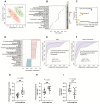Improved Dried Blood Spot-Based Metabolomics: A Targeted, Broad-Spectrum, Single-Injection Method
- PMID: 32120852
- PMCID: PMC7143494
- DOI: 10.3390/metabo10030082
Improved Dried Blood Spot-Based Metabolomics: A Targeted, Broad-Spectrum, Single-Injection Method
Abstract
Dried blood spots (DBS) have proven to be a powerful sampling and storage method for newborn screening and many other applications. However, DBS methods have not yet been optimized for broad-spectrum targeted metabolomic analysis. In this study, we developed a robust, DBS-based, broad-spectrum, targeted metabolomic method that was able to measure over 400 metabolites from a 6.3 mm punch from standard Whatman 903TM filter paper cards. The effects of blood spot volumes, hematocrit, vacutainer chemistry, extraction methods, carryover, and comparability with plasma and fingerstick capillary blood samples were analyzed. The stability of over 400 metabolites stored under varying conditions over one year was also tested. No significant impacts of blood volume and hematocrit variations were observed when the spotted blood volume was over 60 µL and the hematocrit was between 31% and 50%. The median area under the curve (AUC) of metabolites in the DBS metabolome declined by 40% in the first 3 months and then did not decline further for at least 1 year. All originally detectable metabolites remained within detectable limits. The optimal storage conditions for metabolomic analysis were -80 °C with desiccants and without an O2 scavenger. The method was clinically validated for its potential utility in the diagnosis of the mitochondrial disease mitochondrial encephalomyopathy, lactic acidosis, and stroke-like episodes (MELAS). Our method provides a convenient alternative to freezing, storing, and shipping liquid blood samples for comparative metabolomic studies.
Keywords: MELAS; broad-Spectrum; dried blood spots; metabolomics; targeted.
Conflict of interest statement
The authors declare no conflict of interest. The funders had no role in the design of the study; in the collection, analyses, or interpretation of data; in the writing of the manuscript, or in the decision to publish the results.
Figures





References
-
- Kirwan J.A., Brennan L., Broadhurst D., Fiehn O., Cascante M., Dunn W.B., Schmidt M.A., Velagapudi V. Preanalytical Processing and Biobanking Procedures of Biological Samples for Metabolomics Research: A White Paper, Community Perspective (for “Precision Medicine and Pharmacometabolomics Task Group”—The Metabolomics Society Initiative) Clin. Chem. 2018;64:1158–1182. doi: 10.1373/clinchem.2018.287045. - DOI - PubMed
-
- Guthrie R., Susi A. A Simple Phenylalanine Method for Detecting Phenylketonuria in Large Populations of Newborn Infants. Pediatrics. 1963;32:338–343. - PubMed
Grants and funding
LinkOut - more resources
Full Text Sources
Other Literature Sources

